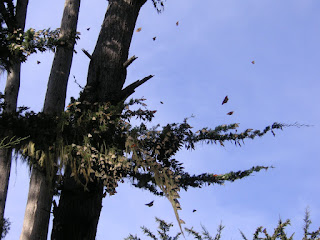monarch butterfly
Danaus plexippus
Danaus plexippus
I don't like to repeat myself on Nature ID too often, but I felt these photos deserved the story they tell. On our way home from the movies (the new Sherlock Holmes film - I've been agog for all things Sherlock lately and have been thoroughly enjoying reading ACD's stories, too), we figured it was such a warm and sunny day that it might be a good time to check out the monarchs in our town's monarch park. We were quite surprised to see so many cars packed outside of the PG Adult School that we drove around to the lesser known access trail. Maybe it was the holiday weekend and the pleasant weather that brought out the visitors in droves?
Come to find out the monarchs are not clustering in the non-native eucalyptus trees in the sanctuary like they often do. Instead, they were primarily located in the neighboring motel yard. This is the first time I've seen monarchs clustered on native trees here in CA, like the Monterey cypress shown in the pictures above. This winter has been filled with a variety of local news and controversy about our overwintering monarchs. Last month, hundreds were found dead on the ground without abdomens and without any satisfactory explanation as to why. Then, there's been the continuing conflict of over-pruning the eucalyptus by the City to avoid another million dollar lawsuit, donors purchasing spendy eucalyptus trees to supplement the pruned trees, volunteers obtaining winter flowering plants, researchers pulling out plants placed by the volunteers, and tubs and tubs of plants purchased that now are left neglected and dying. Sheesh! The petty politics of this town sometimes gets me down. At the very least, it was great to see so many tourists simply enjoying the wonder of a wintering cluster of monarch butterflies.
Come to find out the monarchs are not clustering in the non-native eucalyptus trees in the sanctuary like they often do. Instead, they were primarily located in the neighboring motel yard. This is the first time I've seen monarchs clustered on native trees here in CA, like the Monterey cypress shown in the pictures above. This winter has been filled with a variety of local news and controversy about our overwintering monarchs. Last month, hundreds were found dead on the ground without abdomens and without any satisfactory explanation as to why. Then, there's been the continuing conflict of over-pruning the eucalyptus by the City to avoid another million dollar lawsuit, donors purchasing spendy eucalyptus trees to supplement the pruned trees, volunteers obtaining winter flowering plants, researchers pulling out plants placed by the volunteers, and tubs and tubs of plants purchased that now are left neglected and dying. Sheesh! The petty politics of this town sometimes gets me down. At the very least, it was great to see so many tourists simply enjoying the wonder of a wintering cluster of monarch butterflies.



